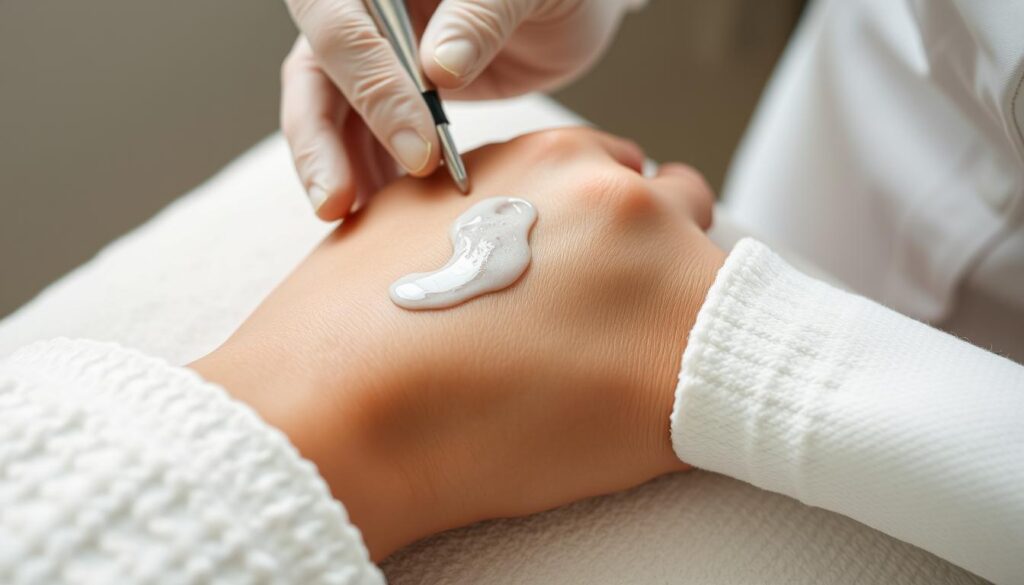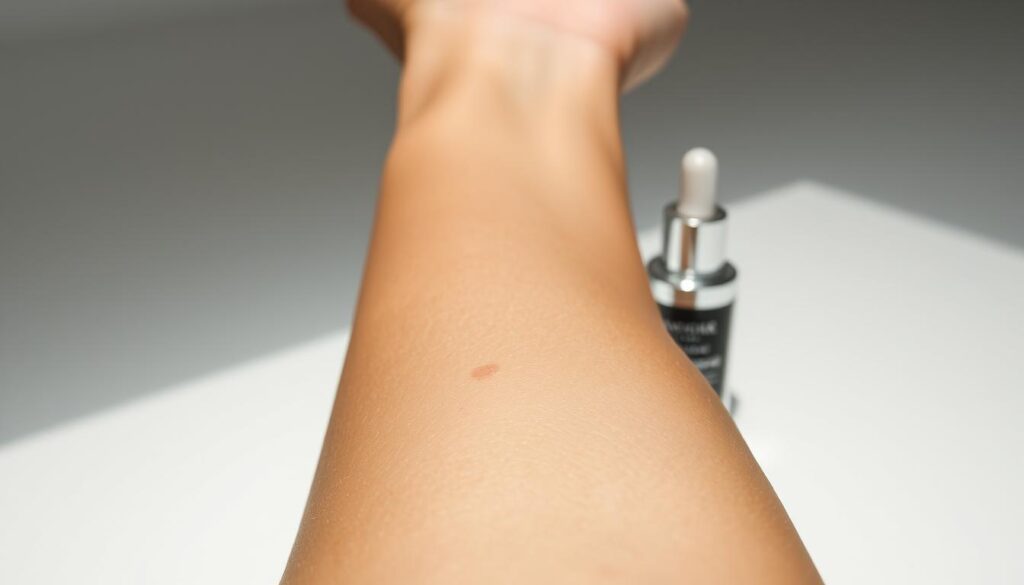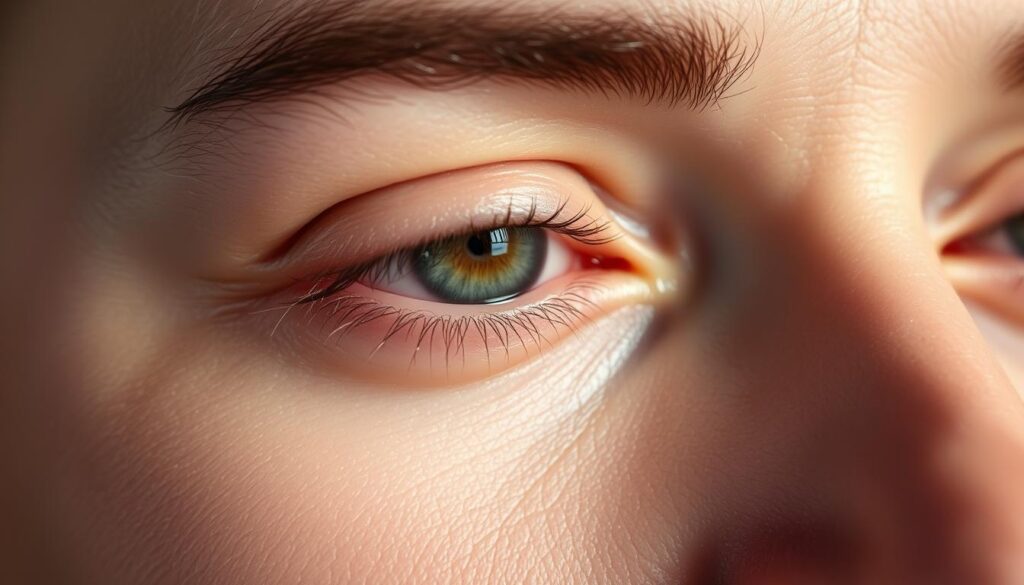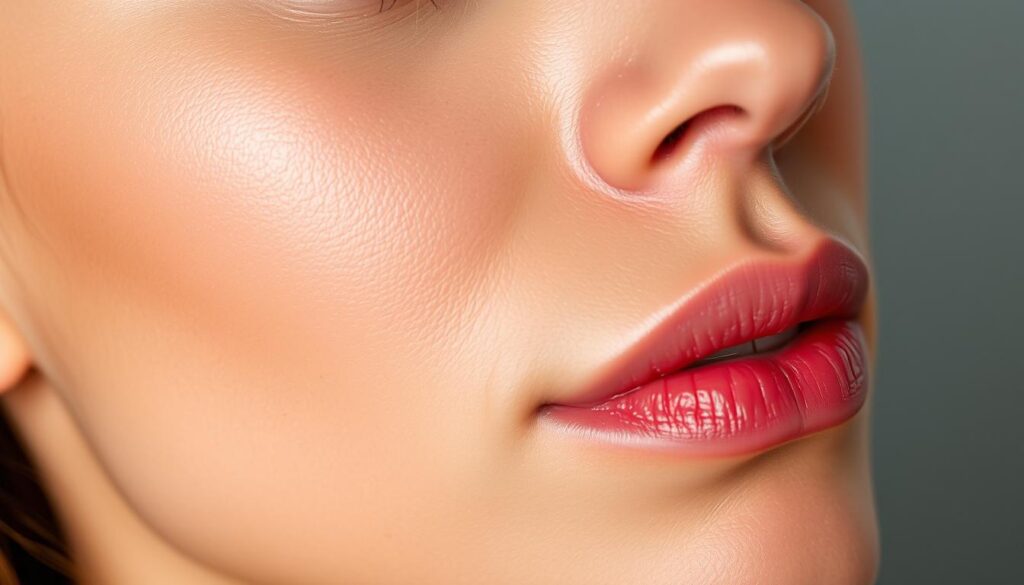Have you noticed dark patches or spots on your skin? These changes in pigment can affect your confidence and overall appearance. This condition, often caused by excess melanin production, is more common in individuals with darker skin tones1.
Whether it’s age spots from sun exposure or melasma triggered by hormonal changes, understanding the root of the issue is the first step toward clearer skin2. The good news? There are effective options available, from over-the-counter products to professional procedures like chemical peels and laser therapy.
In this article, we’ll explore practical insights and solutions tailored to different skin types. You’ll learn how to address these concerns and achieve a more even complexion. Let’s dive in and discover the options that work best for you.
Understanding Hyperpigmentation
Uneven skin tone often stems from excess melanin production. This common condition, known as hyperpigmentation, results in dark patches or spots on your skin. It can affect anyone, but it’s more noticeable in individuals with darker skin tones3.
What is Hyperpigmentation?
Hyperpigmentation occurs when your skin produces too much melanin, the pigment responsible for your skin’s color. This overproduction can lead to dark patches, often triggered by factors like sun exposure, hormonal changes, or inflammation4.
Types of Hyperpigmentation
There are several types of this skin condition, each with distinct causes:
- Age Spots: Caused by prolonged sun exposure, these appear on areas like the face, hands, and neck3.
- Melasma: Often linked to hormonal changes, it commonly affects pregnant women or those taking oral contraceptives4.
- Post-Inflammatory Hyperpigmentation: This type follows skin trauma, such as acne, cuts, or burns3.
Understanding the type of hyperpigmentation you have is the first step toward finding the right treatment. Whether it’s a cream, laser therapy, or lifestyle changes, addressing the root cause is key to achieving a more even skin tone.
Common Causes of Dark Patches
Dark patches on your skin can be frustrating and confusing. Understanding the root of these changes is the first step toward addressing them. Several factors, from sun exposure to hormonal shifts, can trigger these issues.
Sun Exposure and Skin Trauma
One of the primary triggers for dark patches is UV exposure. When your skin is exposed to the sun, it produces more melanin to protect itself. This can lead to uneven pigmentation, especially in areas like your face, hands, and neck5.
Skin trauma, such as cuts, burns, or acne, can also cause dark spots. This is known as post-inflammatory pigmentation. It occurs when your skin produces excess melanin in response to injury6.
Hormonal Changes and Medications
Hormonal fluctuations, particularly during pregnancy or while taking oral contraceptives, can lead to melasma. This condition causes brown or gray patches, often on the face7.
Certain medications, including some antibiotics and anti-seizure drugs, can also increase pigmentation. If you notice changes after starting a new medication, consult your doctor5.
By identifying these causes, you can take steps to prevent or reduce dark patches. Protecting your skin from the sun and addressing underlying issues are key to maintaining an even tone.
Hyperpigmentation: Causes and Best Treatments
Struggling with uneven skin tone? You’re not alone. There are many ways to address dark patches, and finding the right approach depends on your skin type and condition. From over-the-counter products to professional procedures, the options are diverse and effective8.
OTC treatments often include ingredients like azelaic acid, kojic acid, and vitamin C. These products work by gently exfoliating the skin and reducing excess pigment. For deeper concerns, retinoids can help renew your skin’s surface9.
Professional treatments like chemical peels and laser therapy offer more intensive results. Chemical peels use acids to remove the top layers of skin, revealing a brighter complexion. Laser therapy targets pigment with focused light, breaking it down for a more even tone8.
Choosing the right product or procedure is crucial. Your skin’s unique needs will determine which method works best. Consulting a dermatologist ensures you get personalized care and minimize side effects9.
Remember, results take time. Some treatments show improvement in three months, while others may take up to a year. Consistency and proper care are key to achieving your desired effect8.
Over-the-Counter Solutions
Looking for ways to even out your skin tone? Over-the-counter solutions might be your first step. These products are widely available and can be effective for mild concerns. They work by gently addressing uneven pigmentation, making them a great starting point for many.
Face Acids for Gentle Exfoliation
Face acids are a popular choice for smoothing skin tone. Ingredients like vitamin C and azelaic acid exfoliate the top layer of your skin, promoting new cell growth. Vitamin C, in concentrations of 7.5% to 20%, is safe for all skin tones and boosts collagen production10.
Azelaic acid, typically found in 10% concentrations, can reduce dark spots but may cause hypopigmentation in darker skin10. Always start with lower concentrations and consult a dermatologist if you’re unsure.
Retinoids for Deep Skin Renewal
Retinoids, derived from vitamin A, penetrate deeper layers of your skin. They help renew cells and improve texture. While effective, higher concentrations should be used under supervision to avoid side effects like dryness or irritation11.
OTC retinoids are a great first-line treatment for mild pigmentation issues. Consistency is key—results may take up to three months to become visible10.
| Ingredient | Benefits | Considerations |
|---|---|---|
| Vitamin C | Boosts collagen, evens tone | Safe for all skin tones |
| Azelaic Acid | Reduces dark spots | May cause hypopigmentation |
| Retinoids | Deep skin renewal | Higher concentrations need supervision |
Using these products correctly can make a big difference. Always check the strength and frequency of use. For more advanced concerns, professional treatments like chemical peels or laser therapy may be the next step.
Professional Skincare Procedures
If you’re considering advanced options for uneven skin tone, professional skincare procedures might be the solution. These treatments are designed to address more severe concerns and often deliver faster, more dramatic results. However, they require professional guidance to minimize risks and ensure safety.
Chemical Peels
Chemical peels are a popular choice for treating uneven skin tone. They work by removing the top layer of your skin, revealing a brighter, more even complexion. A typical regimen consists of three to six treatments spaced four to six weeks apart for optimal results12.
For severe sun damage, intensive peels may require a recovery period of eight to ten days. While effective, it’s essential to consult a specialist to determine the right peel for your skin type and condition12.
Laser Resurfacing Techniques
Laser treatments offer another advanced option. Ablative lasers remove the outer skin layer, while non-ablative lasers target deeper layers without damaging the surface. Fraxel DUAL, for example, uses fractional technology for faster recovery, leaving some skin untreated12.
Patients often experience redness and swelling post-treatment, similar to a mild sunburn. With continued sessions, long-lasting improvements in skin clarity and texture can be achieved12.
Intense Pulsed Light Therapy (IPL)
IPL therapy is another effective method for addressing flat pigmentation issues. It works by stimulating collagen growth, improving skin tone and texture. This treatment can reduce pigmentation by up to 90% within two sessions, though it’s not suitable for darker skin tones13.
Like other professional procedures, IPL requires proper aftercare to minimize adverse effects. Consulting a specialist ensures you get the best results tailored to your needs13.
Professional treatments can be a game-changer for stubborn skin concerns. While they offer faster results, it’s crucial to follow aftercare instructions and seek expert advice to achieve the best outcome.
Chemical Peels Explained
Are you curious about how chemical peels can transform your skin? This treatment is a popular choice for addressing uneven tone and texture. By removing the top layers of your skin, chemical peels reveal a brighter, smoother complexion14.

Benefits and Risks of Chemical Peels
Chemical peels work by applying a solution to your skin, which removes the outer layers. This process helps reduce discoloration and promotes new cell growth. The depth of the peel determines how much of your skin is affected, with deeper peels offering more dramatic results14.
Benefits:
- Faster results compared to over-the-counter treatments14.
- Smoother skin texture and improved tone15.
- Effective for age-related pigmentation and sun damage14.
Risks:
- Redness, irritation, and increased sun sensitivity15.
- Potential for hyperpigmentation or hypopigmentation, especially in darker skin tones15.
- Deep peels may require longer recovery and carry higher risks14.
Preparation and aftercare are crucial for minimizing side effects. Avoid sun exposure and follow your dermatologist’s instructions to protect your new skin15.
Before starting, consult a specialist to determine the right peel for your needs. Understanding both the benefits and risks ensures you make an informed decision for your skin14.
Advanced Laser and Light Therapies
Exploring advanced laser and light therapies can open doors to clearer, more even skin. These treatments are designed to address stubborn concerns with precision and efficiency. Whether you’re dealing with sun spots, melasma, or post-inflammatory issues, these methods offer transformative results16.
Laser Peel vs. IPL
Laser peels and IPL (Intense Pulsed Light) are two popular options, but they work differently. Laser peels use focused beams to remove the top layers of your skin, encouraging new cell growth. This method is ideal for deeper pigmentation issues and can yield dramatic improvements17.
IPL, on the other hand, uses broad-spectrum light to target pigment without damaging the surface. It’s effective for flat spots like sun damage but may not be suitable for darker skin tones16. Both methods require multiple sessions for optimal results.
Lightening and Resurfacing Techniques
Advanced laser treatments like picosecond lasers deliver energy in ultra-short pulses, breaking down pigment with minimal discomfort. These devices are increasingly refined for safety and efficacy, making them a top choice for many16.
Light-based therapies, such as alexandrite lasers, stimulate collagen production while evening out your tone. Patients often report noticeable improvements in texture and clarity after just a few sessions17.
Customizing your treatment is key. A dermatologist can help you choose the right method based on your skin type and concerns. While these therapies offer rapid results, proper aftercare—like using broad-spectrum sunscreen—is essential for long-term success18.
Microdermabrasion and Dermabrasion Treatments
Are you exploring ways to refresh your skin’s appearance? Microdermabrasion and dermabrasion are two popular options for improving texture and tone. These treatments work by removing layers of skin to reveal a smoother, more even complexion. Understanding their differences can help you choose the right approach for your needs.
Differences Between the Two Procedures
Microdermabrasion is a non-invasive treatment that gently exfoliates the outer layer of your skin. It’s ideal for addressing superficial concerns like fine lines, enlarged pores, and mild discoloration. Each session typically lasts around 30 minutes, with little to no downtime required19.
Dermabrasion, on the other hand, is a more intensive procedure. It removes deeper layers of skin to treat stubborn issues like acne scars or severe sun damage. Recovery can take several weeks, and side effects like redness and swelling may persist for months20.
Ideal Candidates for Abrasion Treatments
Microdermabrasion is safe for most skin types and tones. It’s a great option for those looking for a quick refresh without significant downtime. However, it may not be effective for deeper skin concerns19.
Dermabrasion is better suited for individuals with more severe skin issues. It’s particularly effective for addressing deep scars or uneven texture. However, it may not be recommended for darker skin tones due to the risk of temporary color changes20.
| Treatment | Depth | Best For | Recovery Time |
|---|---|---|---|
| Microdermabrasion | Epidermis | Superficial concerns | None to minimal |
| Dermabrasion | Dermis | Deep scars, severe damage | Weeks to months |
Choosing the right treatment depends on your skin type, condition, and goals. Consulting a dermatologist ensures you receive personalized care and achieve the best results. Whether you opt for microdermabrasion or dermabrasion, proper aftercare is essential for maintaining your new, refreshed look.
Effective Lightening Creams and Topical Treatments
Looking to brighten your complexion? Lightening creams can help. These products are designed to reduce dark patches and even out your skin tone. With the right ingredients and proper use, they can deliver noticeable results over time21.
Active Ingredients to Look For
When choosing a lightening cream, look for key ingredients like hydroquinone and niacinamide. Hydroquinone is effective but requires a prescription due to safety concerns21. Niacinamide, on the other hand, is gentler and helps reduce inflammation while brightening your skin.
Other ingredients to consider include vitamin C and kojic acid. Vitamin C boosts collagen and evens tone, while kojic acid targets excess pigment. Always check the concentration and consult a dermatologist if you’re unsure22.
Usage Tips for Sensitive Skin
If you have sensitive skin, start with lower concentrations of active ingredients. Apply a small amount to a test area first to check for reactions. Gradually increase usage as your skin adjusts21.
Pair your lightening cream with a broad-spectrum sunscreen. Sun exposure can worsen dark patches, so protecting your skin is essential. Reapply sunscreen every two hours for maximum effectiveness22.
Be patient—results may take several months of consistent use. Avoid overusing products, as this can lead to irritation or other side effects. Stick to trusted brands and follow the instructions carefully21.
Tailoring Treatments for Your Skin Type
Your skin type plays a key role in finding the right treatment for dark spots. Whether you have fair, medium, or darker skin, understanding your melanin levels is essential for success. Tailored care ensures better results and minimizes risks23.
Best Options for Fair Skin
Fair skin often responds well to treatments like chemical peels and laser therapy. These methods can target dark spots effectively without causing excessive irritation. However, it’s important to use sunscreen daily to prevent further damage24.
Products with ingredients like vitamin C and retinoids are also great choices. They gently exfoliate and brighten your skin tone. Always start with lower concentrations to avoid sensitivity23.
Considerations for Darker Skin Tones
Darker skin tones require gentler approaches due to higher melanin levels. High-intensity treatments like lasers can increase the risk of discoloration. Instead, opt for lower-intensity procedures or topical products with niacinamide and kojic acid24.
A dermatologist can help customize a plan that works for your unique needs. Personalized care ensures safety and effectiveness, giving you the best results23.
Integrating Sun Protection and Daily Skin Care
Protecting your skin from the sun is one of the most effective ways to maintain an even tone. Daily habits like using sunscreen can prevent further dark patches and preserve the results of your treatments25. Let’s explore how to make sun care a seamless part of your routine.
Choosing the Right Sunscreen
Not all sunscreens are created equal. Look for a broad-spectrum product with at least SPF 30. This blocks 97% of UVB rays, shielding your skin from harmful exposure25. For sensitive skin, opt for mineral-based formulas with zinc oxide or titanium dioxide.
Here are some tips for selecting the best sunscreen:
- Choose a lightweight formula that won’t clog pores.
- If you have oily skin, look for oil-free or mattifying options.
- For dry skin, pick a moisturizing sunscreen with added hydration.
Remember, even on cloudy days, UV rays can still affect your skin. Make sunscreen a non-negotiable step in your morning routine26.
Reapplication Strategies
Applying sunscreen once isn’t enough. Reapply every two hours, especially if you’re outdoors or sweating. Carry a travel-sized bottle for convenience during prolonged activities27.
For makeup wearers, consider a powder or spray sunscreen for touch-ups. These products are easy to use and won’t disrupt your look.
Complementary Skin Care Products
Sunscreen works best when paired with other protective products. Antioxidants like vitamin C neutralize free radicals caused by UV exposure26. Use a serum or moisturizer with these ingredients to boost your skin’s defense.
Here’s a simple daily routine to follow:
- Cleanse your face in the morning and evening.
- Apply a vitamin C serum before sunscreen.
- Use a gentle moisturizer to keep your skin hydrated.
By integrating these steps, you’ll not only protect your skin but also enhance its overall health. Proactive care is the key to slowing the progression of dark patches25.
Holistic Approaches and Natural Remedies
Natural remedies can be a gentle way to support your skin’s health. While they may not replace professional treatments, they can complement your routine and promote a more even tone. Let’s explore some options and when to seek expert advice.
Natural Ingredients for Even Skin Tone
Certain natural ingredients have shown promise in addressing uneven pigmentation. Aloe vera, for example, contains aloin, a compound that helps lighten skin naturally28. Similarly, licorice extract has been found to reduce dark spots caused by sun exposure or melasma28.
Other options include black tea water, which has been shown to lighten dark spots in animal studies28. Tomato paste, rich in lycopene, can also protect against sun damage and improve skin tone28. These remedies are gentle and may work well for sensitive skin.
While these ingredients offer potential benefits, it’s important to remember that clinical evidence is still emerging. Individual responses can vary, so it’s best to test small areas first and monitor your skin’s reaction.
When to Consult a Dermatologist
If natural remedies don’t deliver the results you’re hoping for, it may be time to consult a dermatologist. Stubborn pigmentation issues, such as those caused by hormonal changes or inflammatory hyperpigmentation, often require professional intervention29.
Signs you should seek expert advice include persistent dark patches, worsening discoloration, or if you’re unsure about the cause of your skin concerns. A dermatologist can provide tailored treatments, such as chemical peels or laser therapy, to address your specific needs28.
Combining natural remedies with professional care can create a synergistic effect. For example, using aloe vera alongside prescribed treatments may enhance results and soothe your skin28.
Remember, your skin is unique. What works for others may not work for you. Open communication with a healthcare professional ensures you receive the best care for your skin type and concerns.
Conclusion
Achieving a clear, even complexion starts with understanding your skin’s unique needs. Throughout this article, we’ve explored various factors that contribute to uneven tone and the treatment options available. From gentle topical solutions to advanced procedures, there’s a solution for everyone.
Your skin’s health depends on consistent care and protection. Daily sunscreen use is essential to prevent further discoloration and maintain results30. Combining this with a tailored routine can enhance your skin’s resilience over time.
Remember, professional guidance ensures the best outcomes. A dermatologist can help you choose the right approach for your specific concerns. Whether you opt for conventional methods or natural remedies, consistency is key to seeing the desired effect.
Take the first step toward healthier skin today. With the right plan and support, you can achieve a radiant, even tone that boosts your confidence.



